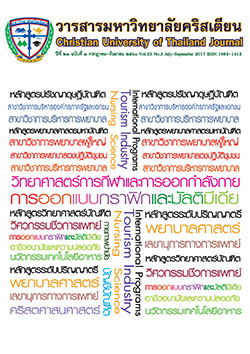การออกกำลังกายและการควบคุมน้ำหนักเพื่อป้องกันการเกิดโรคอ้วนและโรคที่เกิดจากความเสื่อมถอยของร่างกาย
บทคัดย่อ
การป้องกันโรคไม่ติดต่อเรื้อรังของร่างกายถือเป็นประเด็นสำคัญที่ถูกกล่าวถึงอย่างแพร่หลายเนื่องจากการเสียชีวิตจากโรคดังกล่าวมีอัตราสูงขึ้นมากกว่าโรคจากการติดเชื้อโดยอัตราการเสียชีวิตสามารถลดลงได้ด้วยการป้องกันสาเหตุที่ทำให้เกิดโรค การพัฒนาของเทคโนโลยีก่อให้เกิดความสะดวกสบายมากขึ้นและนำไปสู่การเคลื่อนไหวของร่างกายที่น้อยลง เป็นผลให้เกิดภาวะน้ำหนักเกิน และนำไปสู่โรคอ้วนในที่สุด ซึ่งเป็นหนึ่งในสาเหตุสำคัญของการเกิดโรคไม่ติดต่อเรื้อรังถึงแม้ว่าภาวะน้ำหนักเกินจะไม่เป็นปัจจัยเสี่ยงที่ทำให้เกิดโรคโดยตรงแต่ก็ควรมีการป้องกันก่อนที่จะเข้าสู่ภาวะโรคอ้วน การควบคุมน้ำหนักจึงเป็นสิ่งสำคัญสำหรับผู้ที่มีภาวะน้ำหนักเกิน โดยหลักการนั้น การควบคุมน้ำหนักจะต้องควบคุมปริมาณพลังงานที่ได้รับต่อวัน รวมถึงการเพิ่มปริมาณการใช้พลังงานต่อวันให้มากขึ้น เช่น การออกกำลังกาย เป็นต้น หากผู้ที่มีภาวะน้ำหนักเกินปฏิบัติตามหลักการดังกล่าว จะนำไปสู่การลดน้ำหนักที่ถูกต้องและการลดปัจจัยเสี่ยงต่อการเกิดโรคจากความเสื่อมถอยของร่างกาย
เอกสารอ้างอิง
Ahima, R. S., and Antwi, D. A. (2008). "Brain regulation of appetite and satiety". Endocrinology Metabolism Clinics of North America.37(4):811-823.
Alberti, K. G., Zimmet, P., & Shaw, J. (2006). "Metabolic syndrome--a new world-wide definition. A Consensus Statement from the International Diabetes Federation". Diabetic medicine. 23(5). 469-480.
Brown, W. V., Fujioka, K., Wilson, P. W., and Woodworth, K. A. (2009). "Obesity: why be concerned?"American Journal of Medicine.(122):4-11.
Chan, R. S., and Woo, J. (2010). "Prevention of overweight and obesity: how effective is the current public health approach". International Journal of Environmental Research and Public Health. 7(3) : 765-783.
Donnelly, J. E., et al. (2009). "American College of Sports Medicine Position Stand. Appropriate physical activity intervention strategies for weight loss and prevention of weight regain for adults".Medicine & Science in Sports & Exercise.41(2):459-471.
Donnelly, J. E., et al. (2013). "Aerobic exercise alone results in clinically significant weight loss for men and women: midwest exercise trial 2". Obesity (Silver Spring).21(3): 219-228.
Drewnowski, A. (2009). "Obesity, diets, and social inequalities". Nutrition Reviews.67(1): 36-39.
Flegal, K. M., Graubard, B. I., Williamson, D. F., and Gail, M. H. (2007). "Cause-specific excess deaths associated with underweight, overweight, and obesity". Journal of the American Medical Association.298(17):2028-2037.
Fock, K. M., and Khoo, J. (2013). "Diet and exercise in management of obesity and overweight". Journal of Gastroenterology and Hepatology.28(4):59-63.
Guh, D. P., Zhang, W., Bansback, N., Amarsi, Z., Birmingham, C. L., and Anis, A. H. (2009). "The incidence of co-morbidities related to obesity and overweight: a systematic review and meta-analysis". BMC Public Health.9:88.
Hall, K. D., Heymsfield, S. B., Kemnitz, J. W., Klein, S., Schoeller, D. A., and Speakman, J. R. (2012). "Energy balance and its components: implications for body weight regulation". The American Journal of Clinical Nutrition.95(4):989-994.
Han, T. S., Seidell, J. C., Currall, J. E., Morrison, C. E., Deurenberg, P., and Lean, M. E. (1997). "The influences of height and age on waist circumference as an index of adiposity in adults". International journal of obesity and related metabolic disorders.21(1):83-89.
Han, T. S., van Leer, E. M., Seidell, J. C., and Lean, M. E. (1995). "Waist circumference action levels in the identification of cardiovascular risk factors: prevalence study in a random sample". BMJ.311(7017):1401-1405.
Hill, J. O., Wyatt, H., Phelan, S., and Wing, R. (2005). "The National Weight Control Registry: is it useful in helping deal with our obesity epidemic?".Journal of Nutrition Education and Behavior. 37(4) : 206-210.
Hornbuckle, L. M., Bassett, D. R., Jr., and Thompson, D. L. (2005). "Pedometer-determined walking and body composition variables in African-American women". Medicine & Science in Sports & Exercise. 37(6) : 1069-1074.
Klein, S., Allison, D. B., Heymsfield, S. B., Kelley, D. E., Leibel, R. L., Nonas, C., and Kahn, R. (2007). "Waist Circumference and Cardiometabolic Risk: a Consensus Statement from Shaping America's Health: Association for Weight Management and Obesity Prevention; NAASO, the Obesity Society; the American Society for Nutrition; and the American Diabetes Association". Obesity (Silver Spring). 15(5) : 1061-1067.
Poehlman, E. T. (1989). "A review: exercise and its influence on resting energy metabolism in man". Medicine & Science in Sports & Exercise. 21(5) : 515-525.
Powers, S., and Howley, T. (2015). "Exercise PhysiologyTheory and Application to Fitness and Performance". Ninth Edition. New York. McGraw-Hill Education.
Ross, R., Dagnone, D., Jones, P. J., Smith, H., Paddags, A., Hudson, R., and Janssen, I. (2000). "Reduction in obesity and related comorbid conditions after diet-induced weight loss or exercise-induced weight loss in men". A randomized, controlled trial. Annals of Internal Medicine. 133(2) : 92-103.
Ross, R., Freeman, J. A., and Janssen, I. (2000). "Exercise alone is an effective strategy for reducing obesity and related comorbidities". Exercise and Sport Sciences Reviews. 28(4) : 165-170.
Speakman, J. R., and Selman, C. (2003). "Physical activity and resting metabolic rate". Proceedings of the Nutrition Society. 62(3) : 621-634.
Thompson, D. L., Rakow, J., and Perdue, S. M. (2004). "Relationship between accumulated walking and body composition in middle-aged women". Medicine & Science in Sports & Exercise. 36(5) : 911-914.
Wang, J. W., Hu, D. Y., Sun, Y. H., Wang, J. H., Wang, G. L., Xie, J., and Zhou, Z. Q. (2009). "Obesity criteria for identifying metabolic risks". Asia Pacific Journal of Clinical Nutrition. 18(1) : 105-113.
World health organization. (2000). "WHO Technical Report Series 894 Obesity:Preventing and Managing The Global Epidemic. Geneva, Switzerland.



